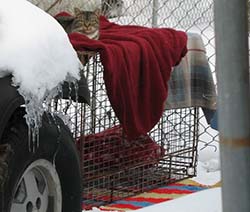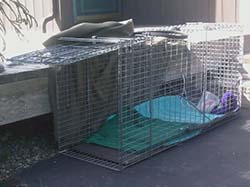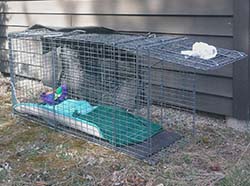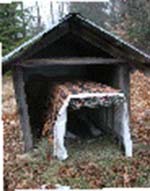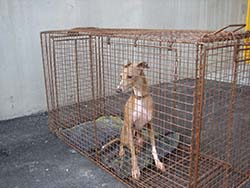Trapping
Cage traps (also referred to as “box” traps) are used to catch domestic and wild animals in a safe, humane manner. Traps are rectangular, built primarily of heavy-duty wire, and made in various sizes. Their sturdy design and all-metal construction withstands constant outdoor use and resists damage. Small traps, used for creatures like skunks or squirrels, are often seen in hardware or farm feed stores. A rear access door (optional) makes it easier to release animals, arrange a blanket, and refresh food. You can lift a four-foot long trap with relative ease, but the five-foot size may prove cumbersome. A six-foot trap is heavy, and awkward to carry any distance without a dolly or someone’s assistance. You’ll need a roomy vehicle, like a truck, van, or SUV, when transporting one of the larger traps.
Every locality has a person in charge of matters relating to animals. Titles for the position include “Animal Control Officer, Humane Officer, and Dog Warden.” This officer should be called immediately when a dog is lost. Also ask about a trap – before you need it. Animal control and care professionals who don’t have a trap, or lack the size needed, may be able to borrow one from an associate. You can also contact rescue leagues, humane societies, and rescue groups for help or advice. A trap should be responsibly set and then cared for by an experienced person who’s familiar with its regulated use. Some communities have a restriction called a “tie up” policy that requires traps to be tied open or shut down, usually from nightfall until daybreak. Established law sets minimum times required for monitoring. Contact the state authority (such as Department of Fisheries and Wildlife) to ask about current laws and regulations on trapping and the use of cage traps. A trap’s owner might have to take a trapper education course, register the trap for identification purposes, or buy a license – even if just trying to catch a dog. Any place that sells licenses for hunting, fishing or trapping can give you information on who to call.
One style of trap has a folding, spring-loaded, entry door, which is in a closed position prior to use. The door on some models is latched and held securely by one or two clips located on top of the trap, towards the front. To open the trap, lift up any clip/s, then push the top part of the door in, and pull the lower part up. For now, hold the door up, or it will spring back into a closed position. Look inside the top right corner of the trap for a small, wire hook – it’s connected to a long rod that runs down to the floor. To “lock” the door up/open, pull on the rod, and adjust the hook so it catches on the wire grid of the door. The other end of the rod is attached to a rectangular, solid-metal plate – this is the trap’s trip mechanism. Moving the rod engages the plate and makes it rise and fall. The trap is “set” when the door is hooked up and the plate is in a raised position. When an animal steps down hard enough to flatten the trip plate, the rod moves, the hook slips off the grid, and the door springs shut very quickly – trapping the animal inside. A small adjustment can be made to the amount of pressure needed to trip the plate by snagging the hook completely onto the grid (more pressure required), or just barely catching on it (less pressure needed).
A second style of trap features a different design for the entry door and the trip mechanism. The door is held closed by two metal rings – one on each side near the bottom of its frame. Slide the rings up, open the door, and hold it for now. Look for two, short, 90-degree hooks inside the top left corner of the trap. One’s at the end of the door, and the other is at the end of a long rod. The square pad of wire resting just above the floor in the back is the trip mechanism. A length of chain connects the trip pad to the long rod. Turning the rod by its hook makes the pad rise and fall. To lock the door open, adjust the rod’s hook to rest on the door’s hook. The trap is “set” when the door is locked up and the pad is in a raised position. If an animal steps down hard enough to depress the trip pad, the chain is pulled down, the rod is pulled backward, and the two hooks disengage. This causes the rings to fall and the door to shut down quickly. The rings secure the closed door – trapping the animal inside. To adjust the pressure needed to trip the trap, set the hooks to rest securely on each other (more force needed), or just barely catching (less force).
Set a trap in the yard from which the dog bolted, or in the immediate area of verified sightings. To find a spot it favors, or might favor and visit again, go to every location where the dog’s been seen. Knock on doors to deliver fliers and tell residents you’re looking for suitable places to put a cage trap. People are more apt to allow a trap to be set up on their property if they’re told that animal control and care professionals use these humane traps on a routine basis in order to safely catch lost and stray dogs. One must secure permission from the landowner before placing a trap on private property. If you’re not sure who it is, ask the neighbors first, then check with police or the assessor’s office at city/town hall. Pick the spot for a trap with care – your best efforts can be hindered by local pets that are free to roam, feral cats, curious children, “happy to help” adults, or a quiet location that suddenly becomes very busy. A good site lets the dog approach and investigate a trap without feeling threatened, and allows frequent monitoring without disturbing anyone. Ideally, it should be sheltered next to a building or solid fence, placed near a path the dog uses, or at the edge of a lawn abutting a field or wooded area. A trap must be set on a relatively flat, firm surface so it remains steady and doesn’t wobble when the dog ventures inside. Push down on the top to check for stability. If it rocks, level the ground or reposition the trap as needed. While searching for your dog and working the trap, be considerate of those who live nearby and respect their privacy. Nobody appreciates a noisy stranger who’s walking around late at night with a flashlight.
Many dogs don’t like the feel of the wire floor as they step inside a cage trap, and back right out. To provide a solid surface to walk on, cover the entire floor with a heavy towel, rug, or small blanket. Don’t cover the first few inches of wire in the entry of a spring-loaded door – it may not shut securely. If the trap is placed on wet ground, the floor cover will absorb moisture and get damp or soaking wet. To keep it dry, place a waterproof barrier either under the trap, or inside – directly on the wire floor. Use rubber mats (bath, car, floor), tarps, or shower curtain liners with care. A trap can slide around if placed on a slippery surface. If using a barrier inside, the cover blanket (or towel) must stay put as the dog walks on it. Dogs often avoid stepping on a trip mechanism because it’s a “hill.” If needed, scrunch up the cover a little to hide the hill. Another trick is to set a small log about six inches in front of it. When the dog steps over the obstacle, a paw should land firmly enough to trip the trap. The size of the obstacle should be matched to the dog (Chihuahua or German Shepherd) that you’re trying to catch.
Items with familiar scent on them, such as the dog’s blanket, bedding, hair, hairbrush, toys, collar, leash, and travel kennel, have immense value when it’s lost. Don’t wash out the “doggy” smell. Bedding can be used to cover the floor inside a cage trap; a large blanket can be thrown over the outside. A lost dog is more inclined to go into a warm and cozy place if its blanket and favorite toy are inside. Don’t overstuff a trap – leave room for the dog to walk in, turn around, and be comfortable. Secure a toy (stuffed or rope type) to the rear wall – the dog should trip the trap while tugging on it. The person most bonded to the dog should put a worn, unwashed article of clothing inside the trap, such as a T-shirt that’s been worn several days in a row. If the dog is a “rescue” lost during transport, or newly adopted, use old but recognizable scents from a foster home, shelter, rescue worker, or canine buddy. When mailing an item, scent stays fresher if sealed tightly in a plastic bag. Leave a pile of worn clothing or other items at a sighting location until the trap can be set up. Walk the dog’s canine pack members in a prime trapping or sighting location to lay down their scent. To leave a very personal mark, use a spray bottle to spritz urine on cotton balls, small rags, or the ground. The smell of puppies may interest a female. The scent of a female in season may attract a male, even if he’s neutered. Stuffed toys can hold scent or pique interest. It should be a bit easier to catch the dog if it’s already familiar with crates or kennels. If waiting for a trap to arrive, find a sheltered spot to fix up a kennel or crate as a bedding area – leave the food bowl outside. This gives a dog more room to rest and reduces the number of animals exploring the dog’s bed for food.
Cage traps are covered to protect animals from exposure to weather and keep the interior dry. Comforters, blankets, and quilts are easy to use and help hold down a waterproof tarp (if using one). A thick comforter or several layers of blankets provide extra insulation during the winter months. The trap should be covered in such a way so that cold drafts are eliminated, especially near the bottom. Loose material that flaps or flutters on a windy day can scare the dog away – fold, cut, or weigh it down. Secure stray edges that might fall into the entrance and prevent the door from closing down tightly. Dogs are usually less suspicious of a trap camouflaged like an animal den. Materials to use include: burlap, small branches, pine needles, leaves or other forest debris, and bales of straw (not hay). Straw placed around the outside of a trap provides excellent insulation. Hide the first few inches of exposed wire inside the entrance using a few leaves, some grass clippings, or a little straw. The entrance must be cleared of rocks, pinecones, sticks, or stumps that could prevent the door from closing tightly. Check inside, outside, and underneath for obstructions, then open and close the door to make sure it works right. Covered traps are generally more successful – throw something on yours, even if the weather is pleasant.
Always test a trap’s function. Estimate how hard the lost dog will step on the tripping mechanism, then try to trip the trap by applying the same pressure with your hands, a dog of similar size, or a sturdy stick. If you think the lost dog doesn’t weigh enough to trip the trap being used, put a small rock, brick, or piece of wood on the trip plate or pad to adjust its sensitivity. Counterweights can’t touch or interfere with a rod or chain and must be placed well off to the side, allowing room for the dog to step through easily.
Lost dogs are always hungry – use several aromatic foods to make your bait dish irresistible. Don’t overfeed a starving dog – small but steady portions of food are more easily tolerated. Try meatballs in red sauce, dark turkey meat, pizza, or wet dog food with bacon bits or cheddar cheese. Cooked hot dogs are tasty, and easily bagged to carry around as pocket-sized emergency dog treats. De-bone all meats – don’t risk someone’s pet choking on the bait you put out with good intentions. Don’t use cat food unless you’re checking on the trap frequently – cat food attracts cats very quickly. Tie a few hot dogs, a hunk of meat, or bacon strips (attached to paper plate) to the top rear of a trap with a thick cord (string = choke hazard). Leave few tidbits outside – the goal is to entice a hungry dog inside. Set a small to medium-sized bowl at the rear of a trap, past the trip plate or on the rear of a trip pad. A big bowl just makes it easier for dogs not to step on a trip mechanism – they simply lean over and eat.
Extreme temperatures, insects, small rodents, and other things take a toll on food – in or outside a trap. Bait needs to be fresh and appetizing – replace anything old, rancid, or frozen – as quickly as possible. To warm up cold/frozen bait – put it in a plastic bag placed on the dash and turn the defroster on high. Offer a separate bowl of dry kibbles if you’re not around to warm up frozen bait as often as you should. Provide fresh (unfrozen) water so the dog doesn’t have to leave the area in search of a natural source. If a dog has to crouch to go into the trap then it’s tall enough to hit the door’s overhang by accident. Don’t put bait on top of or underneath the overhang – the door will trip if the dog nudges it enough. A trap must be able to accommodate a dog that’s crouches down and stretches out as it steps inside. When a cautious dog trips a trap, it senses something’s “wrong” and tries to back out immediately. If the dog doesn’t back up fast and far enough, the door will come down on its backside. If the dog moves forward, the door will finish closing and trap it inside – startled but safe. If the dog continues backing up, the door will finish closing with the dog on the outside looking in. A dog may approach a trap, but hesitate to go in. Assess the situation to see if both you and the dog can afford to wait – hunger usually overrides caution. If you do feed the dog outside the trap, provide several small meals throughout the day. Use the same bowl for every meal and keep moving it closer to the trap – as fast as possible. Once the bowl is placed inside the trap use a combination of foods the dog will find hard to resist.
You can see from a distance if a trap’s been tripped by tying a square of white cloth or reflective material to the front door. The material must be secured so it doesn’t flutter around, blow off, or interfere with the closing of a tripped door. This is NOT a substitute for walking up close to and checking a trap.
In case of an emergency or other serious matter, people need to be able to identify and contact those responsible for setting up and maintaining the trap. Use your flier (or plain paper) to provide the names and 24/7 phone numbers of at least two people who can be reached without a problem. Seal it in a weatherproof plastic bag and attach to or next to the trap in a visible, easily found location.
Don’t rush to let your dog out of the trap – it may be confused or excited and bolt right past you. Take the dog (still in the trap) to a vet’s office, home, or animal shelter, then release it inside a building. If you’re sure the dog can’t escape, release it from the cage trap in an outside kennel or fenced-in yard.
Careful preparation and proper maintenance of a trap helps catch a lost dog that much sooner. Check on a regular basis to release unwanted animals and get the trap back in operation quickly. A golden opportunity is wasted if the dog approaches your trap but there’s already a “guest” inside. With or without food inside, a trap can be tied open so the dog gets accustomed to being around it. It can be set up as a bedding trap – with food being supplied nearby. Use a trap to best fit the situation. Bad weather’s coming? Too cold or very late and you have to go home? If you can’t be there to check the trap responsibly, remove the food and shut it down until you can. Remember – the purpose of a humane cage trap is NOT to endanger the well-being of wild or domestic animals. Don’t allow an animal to be needlessly trapped for hours because you didn’t think it would matter that much – it just may.
Wear gloves and wash your hands after handling things an animal might have licked, marked with urine, or left traces of blood or scat on, including dishes, bedding, toys, covers, and the trap itself. There are many reasons why a cage trap must be used with care – work the trap with a local professional. Anyone working a trap needs to know how to release “guests” in a safe manner before a situation arises. An animal may back into a corner, but can lash out quickly and unexpectedly. Watch your fingers when opening the trap so you don’t get scratched or bitten. If there’s no rear access door, prop up the front door, then walk away and give the animal a few minutes to venture out on its own. A professional who’s had training or experience should handle the release of wild animals and any “very angry” domestics.
Grabber “tongs” can help arrange and retrieve items inside traps without a rear door access. Tongs are relatively easy to find at stores that sell specialty items for elderly or handicapped people.
WARNING…CAN YOU FIT INSIDE THE TRAP? USE TRAPS WISELY and RESPONSIBLY.
It’s easy to press down on a trip mechanism and accidentally trap yourself! If there’s a rear door, just push it up and crawl out. If you’re stuck, you have to get out on your own or call someone to let you out. If crawling inside, the door must be tied up securely. Lacking a rubber tie down or rope, prop the door up with a sturdy stick, take 2 wire coat hangers and cell phone inside, and leave one leg outside the entrance. With a bi-fold door trap, push up any latch clip/s and reach through the upper half of the door grid with a hanger. Hook the outside grid and pull it towards you, then push the bottom of the door out. To get out of a ring trap – push the rings up and open the door with a foot – your hands are busy holding up the rings. It’s scary to hear a trap door slam down behind you, and humbling to be so stupid. Never put yourself or others at risk, especially while working in remote locations or during foul weather conditions.
www.lostdogsearch.com
Debbie (Hall) Scarpellini copy 2/2009

